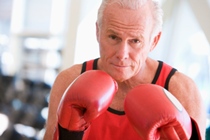 Across the country, an increasing number of people with Parkinson’s disease are taking back control over their lives from the disease. They are filing into various classes, like boxing, dancing, drumming, tai chi, and more, displaying their mastery over their bodies that their condition tried to strip from them.
Across the country, an increasing number of people with Parkinson’s disease are taking back control over their lives from the disease. They are filing into various classes, like boxing, dancing, drumming, tai chi, and more, displaying their mastery over their bodies that their condition tried to strip from them.
The majority of Parkinson’s patients—of which there are about a million—are diagnosed with the condition in their 60s, but that doesn’t mean younger people are in the clear. About 10%–20% of cases are diagnosed in people under 50. Sometimes, it causes rapid degeneration; other times, it is more drawn out.
As the population ages, it is expected that another 50,000 cases will be diagnosed this year. And that number will likely grow in the future. For those who are unaware, Parkinson’s is a nervous system disorder that’s signified by reduced control over one’s muscles. It typically leads to tremors, loss of balance, and difficulty walking or speaking.
Fortunately, each day, researchers and health professionals are finding new ways to help combat the disease and its symptoms. And it turns out that regular exercise classes, like boxing and tai chi, may be the key to reducing your risk of Parkinson’s disease or taking back control over your body.
Boxing Classes Making a Big Difference for Parkinson’s Patients
A National Public Radio (NPR) report recently highlighted a gym in Rhode Island called “Rock Steady Boxing” that’s dedicating classes to Parkinson’s patients in order to help them battle the disease. The classes have participants ranging in age from 46 to 84. They work on boxing drills, hit a heavy bag, and perform calisthenics and stretching.
Although boxing doesn’t cure the disease, it does make it more manageable. One participant indicated that his time in the gym makes him feel stronger and more mobile, even extending the time between his medication from three to six hours. In addition to the physical benefits, he reports improved self-confidence and relief from depression.
But boxing is not the only activity that’s been showing positive results for Parkinson’s patients who are getting active. Dancing, tai chi, walking on a treadmill, golf, and weight training are all showing benefits, regardless of the patient’s age and physical condition. As was mentioned earlier, most are not diagnosed with Parkinson’s until they are in their 60s.
What Science Is Saying: Tai Chi, Moderate Exercise May Prevent Progression of Parkinson’s
One of the most heavily studied exercise methods regarding Parkinson’s is tai chi. This Chinese method of exercise involves slow movements that emphasize balance, stretching, strength, and a very important mind-muscle connection. So far, it’s proven to improve motor coordination, flexibility, grip strength, balance tremors, walking ability, and other aspects of gait.
In a 2012 study, Parkinson’s patients who practiced tai chi twice a week for six months displayed better balance and control over their movements than people who did weight training or stretching. The group who weight trained had better balance and less falls than the group who just stretched.
Because of the mind-muscle connection and relaxing “mindfulness” of tai chi, it might produce better effects than other forms of exercise. This is largely because it engages the whole body in an upright position, using natural, fluid movements that are quite similar to those you often make in daily life. Slower and more focused, yes, but similar nonetheless. It’s quite possible that performing these movements in a concentrated fashion during tai chi improves the mind-muscle connection, so Parkinson’s patients have more control in real time. A research team at Harvard Medical School is currently closely studying the relationship.
It’s also possible that moderate exercise can be a preventative measure for Parkinson’s. A Swedish study tracked 43,000 people for almost 13 years, and noticed that the risk of Parkinson’s was cut in half for those who engaged in moderate levels of exercise.
So it seems that you can fight back against Parkinson’s disease, with a growing body of research indicating exercise can be effective for treating and preventing the rapidly growing condition that affects more people than ALS, MS, and muscular dystrophy combined!
Talk to your doctor to find out what you can get involved in to minimize your risk or halt Parkinson’s progression, or see what’s happening in your area at local community centers, senior centers, or gyms. Whether it’s tai chi, dancing, or boxing, if you regularly participate in a program, you can potentially reduce your risk of falls and other injuries that can come as a result of Parkinson’s. The exercise can also help battle depression that is common in people with chronic or degenerative illnesses, so it’s highly recommended to take a closer look at this natural, healthy form of therapy.
Sources for Today’s Article:
Li, F., et al., “Tai Chi and Postural Stability in Patients with Parkinson’s Disease,” New England Journal of Medicine 2012; 366: 511–519.
“Neuroprotective Benefits of Exercise,” National Parkinson Foundation web site; http://www.parkinson.org/Parkinson-s-Disease/Treatment/Exercise/Neuroprotective-Benefits-of-Exercise, last accessed February 5, 2015.
Yang, F., et al., “Physical Activity and Risk of Parkinson’s Disease in the Swedish National March Cohort,” Brain February 2015; 138(Pt 2): 269–75, doi: 10.1093/brain/awu323.
Knox, R., “Fight Parkinson’s: Exercise May Be the Best Therapy,” NPR web site, February 2, 2015; http://www.npr.org/blogs/health/2015/02/02/381937503/fight-back-against-parkinsons-exercise-may-be-the-best-therapy?sc=ipad?f=1128.
